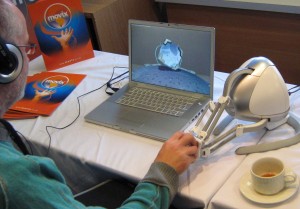The ATC assists staff members in fulfilling accessibility standards for campus facilities. Contact the Access Technology Center for information about commonly used and supported products. Disability Resources for Students (uwdss@u.washington.edu or 3-8924) can offer further information.
Universal Design
Universal design promotes access through the practice of designing facilities and services for a broad range of abilities, not simply for average users. Keep in mind that faculty, students, and staff using your lab may have learning disabilities or visual, speech, hearing, and mobility impairments. Be sure that staff are trained to support people with disabilities and have a plan in place to respond in a timely manner to specific accommodation requests.
Physical Access
- Ensure accessible routes from the building entrance to the lab are clearly marked, wheelchair-accessible and easy to navigate.
- Mark the location of other accessible features (accessible restrooms, building entrances, parking etc.) on signs and maps.
- Ensure doorway openings are at least 32 inches wide and doorway thresholds are no higher than 1/2 inch. Consider providing automatic door openers for large or heavy doors.
- Make aisles wide and clear for wheelchair users. Remove protruding objects for the safety of those who are visually impaired.
Policy and Procedures
- Develop written policies assuring IT access for disabled users.
- In key lab documents, indicate commitment to universal access and describe procedures for requesting disability accommodations.
- Example: “Our lab is committed to making resources available to all qualified students. Contact lab staff to report access barriers. Contact lab staff or Disability Resources for Students (543-8924) to request specific accommodations.”
- Ask software vendors about product accessibility, and purchase lab software with accessible features.
- Develop a quick-response procedure for requests involving adaptive technology not yet available in the lab.
- Train staff on built-in accessible features of products as well as adaptive technology available in the lab.
Computer/ Laboratory Software
- Provide printed resources in a location that can be reached by a wheelchair user.
- Provide at least one adjustable-height table for each type of workstation in your lab.
- Use high contrast (black & white/yellow & black) and large print on signs.
- Provide key documents in alternate formats (large print, braille, electronic document).
- Provide a trackball/mouse alternative, simple text-to-speech and screen enlargement software, large print keytop labels, and a large monitor (17+ inches).
- Label computers with accessible features. Use large print and braille labels.
- Ensure PDF documents used in your facility meet PDF Accessibility Requirements.
Additional Technologies
Once a lab is established or has greater user requirements, consider adding additional software and hardware such as:
- A tray-fed scanner and optical character recognition (OCR) software
- A CCTV (Closed Circuit Television) for text enlargement
- A braille embosser and braille translation software
- Word prediction software
- Additional alternative pointing devices
- Alternative keyboards (miniature/extended/one-handed keyboards, switch-based interfaces, virtual keyboard software)
- Speech input software
- Hearing protectors (for users distracted by ambient noise)
Web Resources
Many online resources are available to help individuals meet accessibility standards.

